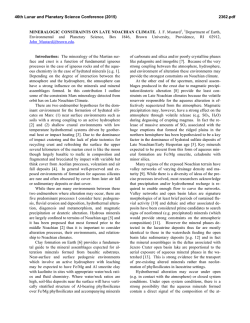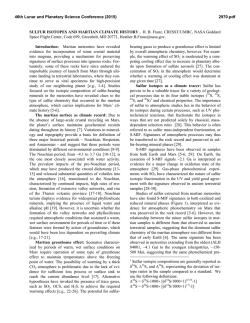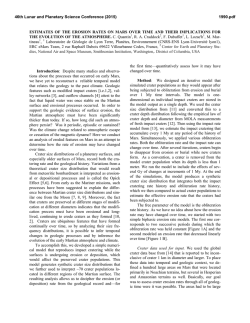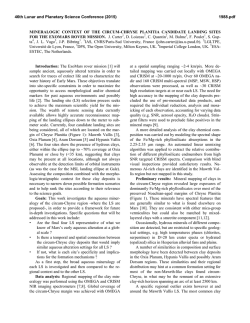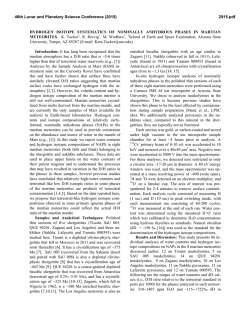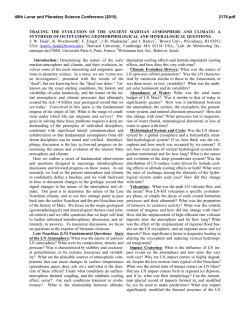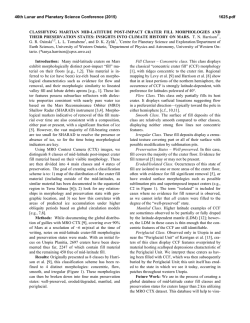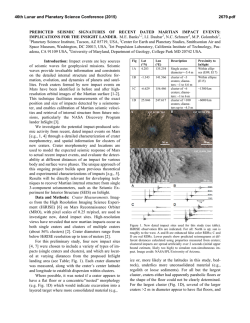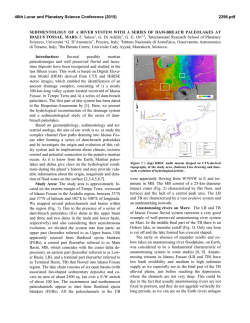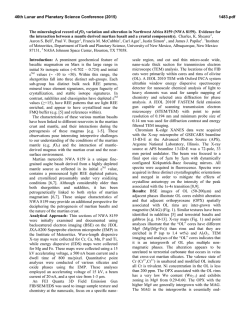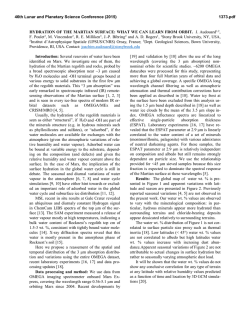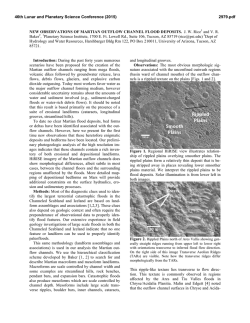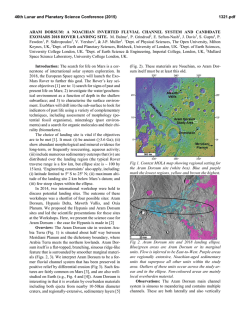
GEOLOGY AND ATMOSPHERIC SCIENCE FOR EARLY MARS
46th Lunar and Planetary Science Conference (2015) 2946.pdf GEOLOGY AND ATMOSPHERIC SCIENCE FOR EARLY MARS: SYNTHESIS AND SYNERGIES. L. Kerber, Jet Propulsion Laboratory (4800 Oak Grove Dr. Pasadena, CA 91109, [email protected]) Introduction: Data returned from the surface of Mars during the 1970s revealed intriguing geological evidence for a wetter early martian climate. Since this time, geological investigations into early Martian history have attempted to ascertain the nature and level of activity of the early Martian hydrological cycle while atmospheric modeling efforts have focused on how the atmosphere could be warmed to temperatures great enough to sustain such activity. The best synergy between atmospheric models and geologic investigations takes place when important model parameters can be clearly determined from geologic evidence. Clear parameter ranges can be used to bracket the model domain, allowing modelers to explore the sensitivity of the physical system. The outputs of climate models can be used to test predictions, interpolate between data points, and also to see where additional geological investigations are needed in order to better constrain the parameters to which the model is most sensitive (Fig. 1). Geological investigations into the nature of aqueous activity on the surface of Mars often yield important parameters of use to atmospheric modelers, but the investigations are not always performed or reported with this end in mind. Some of the most important parameters for Noachian climate models are outlined in Figure 1. Of these the “duration of surface warming” is the one most often addressed by geologists. Figure 1. Synergy between atmospheric models and geological investigations. Thus far aqueous activity has been invoked to explain numerous spatially and temporally distinct morphological and chemical signatures, including: 1) iron and magnesium-rich clays, appearing in the oldest Martian terrains [1-2]; 2) high erosion rates, taking place throughout the Noachian [3]; 3) sedimentary layering [4]; 4) valley networks, dated to the lateNoachian/early-Hesperian [5], and 5) iron, magnesium, and calcium-rich sulfate deposits; dated to the lateNoachian/early-Hesperian [1]. What constraints do these observations place upon the nature of the ancient atmosphere? 1) Widespread iron and magnesium-rich clays suggest the occurrence of a period of pH-neutral aqueous alteration [1-2] during the early Noachian or before. If these clays formed at the surface, they would require a climate conducive to the sustained presence of liquid water; however, surface formation is not strictly required [2]. The locations, assemblages, and accompanying minerals of most of the clays so far detected favor a formation in a diagenetic, hydrothermal, or magmatic system [2]. Aluminum-rich clays appear in late Noachian strata: these may indicate a late-stage surface clay-forming period during which surface waters caused the leaching of mafic lithologies [2]. In summary, iron and magnesium rich clays of Mars do not offer clear constraints on the state of the Martian atmosphere, while Al-rich clays could suggest that a limited period of surface water weathering occurred in the late Noachian [2]. 2) High erosion rates taking place during the middle and late Noachian have led to degraded crater rims and significant crater infilling [3]. While these rates of erosion are high compared to current Martian erosion rates, they are still on the lower end of terrestrial rates [3]. Adjacent Noachian craters of similar size can show large differences in preservation state, meaning that the process of gradation was likely slow or intermittent over ~200 million years [3]. The erosion of craters and basins during most of the Noachian seems to record a different signal from the later valley networks and suggests that while there may have been a “climate optimum” at the end of the Noachian, surface flow was not confined to this time period [3]. This type of erosion, acting over ~200 million years, seems to have taken place slowly or intermittently [3]. During this prevalley-network era, the atmosphere must have been thick enough and warm enough to permit precipitation, but not enough precipitation to cause widespread incision [3]. 3) While it is generally agreed that sedimentary layering requires aqueous activity over a significant amount of time, it is not simple to estimate the precise amount of time which is needed. The reason for this is that highly active hydrological systems can deposit many thick layers in short periods of time, while inter- 46th Lunar and Planetary Science Conference (2015) mittent hydrological systems could require more time (by an order of magnitude or more) to emplace an identical set of layers. This ambiguity is compounded by the difficulty of definitively identifying fluvial or lacustrine sedimentary layers from volcanic, aeolian, or impact-generated layers. Indeed, many Martian layered deposits could have resulted from an interplay between aeolian and aqueous activity in which aeolian processes delivered sediment to a basin, and groundwater cemented it [5]. Layers such as these could form in a wide variety of climatic conditions, requiring only variations in sediment input or ground water flow. Sedimentary deposits which are unequivocally fluvial, such as deltas, provide some constraints. For example, the presence of river meanders in the Holden Crater delta suggests “prolonged” fluvial activity (as opposed to catastrophic floods), but the time required to form meanders can also vary greatly (from tens to thousands of years, depending on the substrate; [4]). 4) Valley networks impose some of strongest constraints on the early Martian climate. Some chains of river valleys and craters lakes extend for thousands of kilometers, requiring pressures high enough and temperatures clement enough for sustained flow [5]. Like sedimentary layers, it is difficult to say how much time was necessary for the valley networks to be carved. Low flow rates over long periods of time can yield similar morphologies to high flow rates over shorter periods. In addition, systems that are continuously active can erode the same volume of material in less time than systems with long periods of inactivity between erosion events [7]. There are some ways to help resolve this ambiguity. For example, if a crater has both an inlet and an outlet channel, it means that the flow rate was rapid enough (compared to the evaporation rate) to fill up the crater and breach the other side [6]. For these craters, maximum volume estimates can be made. From the large volumes of these ancient lakes, it can be estimated that they would have had to have been present for tens to thousands of years [6]. The fact that many craters do not have exit channels places upper limits on how much water could have come at one time. Based on landscape evolution models, it appears that massive floods of water, capable of carving valley networks in tens of years, should have left more exit breaches than are currently seen on the surface [7]. The absence of these breaches indicates that valley networks were probably formed through numerous moderate flood events rather than several large deluges, as might be expected from impact-generated climate excursions [7]. Some valley networks have high drainage densities and extend up to drainage divides, providing evidence that some networks were fed by precipitation (rain or snowfall). Importantly, a hydrological cycle is needed 2946.pdf which is able to recycle water from the lowlands back to the highlands (i.e., the one-time emptying of a regional aquifer would not be sufficient to create the observed features) [5]. Of all of the aqueous processes identified on Mars, the valley networks provide the clearest constraints: the atmosphere must have been thicker, the surface temperature must have been warmer (>273 K assuming pure water, tens of degrees lower for brines), and system recharge (likely in the form of rain or snow) must have been possible. Assuming a continuous flood of water, (at mean-annual Earthlike levels), valley networks like Paraná Valles would have taken thousands to tens of thousands of years to form [7]. Such floods were probably episodic, however, and the periods of inactivity between them is unknown. Intermittency of fluvial activity could increase the required time by several orders of magnitude [7]. The period of widespread valley network formation appears to have ceased abruptly near the NoachianHesperian boundary, with only localized valleys forming later in Martian history [6]. 5) Widespread iron, calcium, and magnesium sulfates appear in late Noachian/Hesperian terrains [1]. Three possible scenarios have been suggested to explain the presence of these minerals: first, that they are evidence of a global acidification event, in which acidic surface waters in equilibrium with a SO2saturated atmosphere triggered the production of massive sulfates [1]. Second, that the sulfates were formed from the evaporation of sulfur-rich groundwater, in which case sulfate deposits would correlate with ground water seeps and springs [5] or third, that the sulfates were formed from the oxidation of sulfide-rich basalts under an ordinary CO2 atmosphere, in which case the sulfates would be correlated with regions of sulfide-rich basalts [8]. Of these, only the first would provide a strong constraint on the ancient Martian atmosphere. The enumeration and refinement of these types of constraints, as well as the recognition of enduring ambiguities, can help atmospheric modelers furnish their models with more accurate parameters. In turn, by testing the sensitivity of the models, the modelers can identify which parameters need to be better constrained, which can inspire more pointed geological investigations. References: [1] Bibring J.-P.et al. (2006) Science 312, 400-404. [2] Ehlmann B.L. et al., 2011 Nature 479, 53-60. [3] Irwin R.P. et al. (2005) JGR 110, E12S15. [4] Moore J.M. et al. (2003) GRL 30, 2292. [5] Andrews-Hanna J.C. (2010) JGR 115, E06002. [6] Fassett C.I. and Head J.W. (2008) Icarus 198, 37-56. [7] Barnhart, C.J. (2009) JGR 114, E01003. [8] Dehouck E. et al. (2012) Geochim Cosmochim Acta 90, 47-63.
© Copyright 2026

